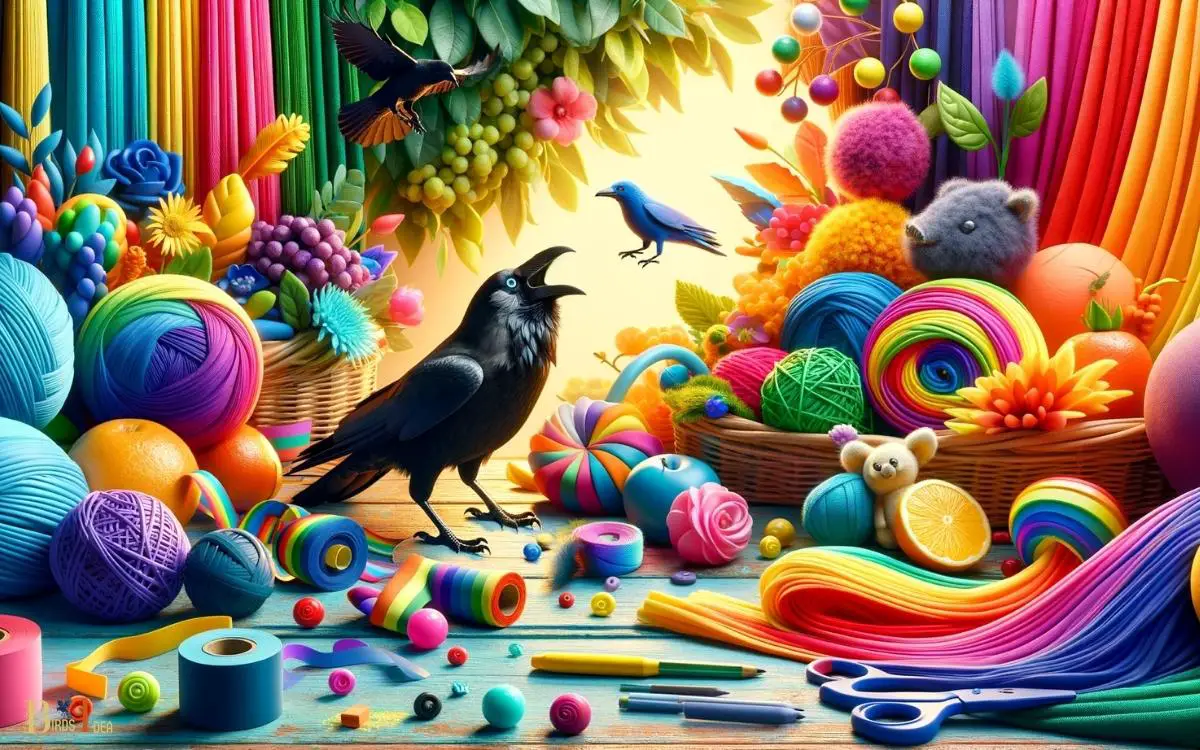What Colors Do Crows Like: Find Out!
Crows are generally attracted to shiny or bright objects, but there is no definitive evidence showing a preference for specific colors.
Crows’ attraction to objects is often based more on their curiosity and the novelty of an item rather than its color.
Crows are highly intelligent birds with complex behaviors, and their interest in objects can be influenced by various factors.
While there is no clear scientific consensus on color preference, crows are known to investigate and sometimes collect shiny or bright items, which may be due to the objects’ visibility rather than an innate preference for color.
Factors influencing a crow’s interest in an object include:
- Novelty: New or unusual items may pique a crow’s curiosity.
- Utility: Objects that can be used for nesting or tool-making may attract crows.
- Food association: Crows may associate certain colors with food sources.
While crows don’t exhibit a specific color preference, their attraction to novel and shiny objects underscores their complex cognitive abilities and inquisitive nature.

Key Takeaway
The Vision of Crows
Studying the vision of crows reveals their remarkable ability to perceive a wide spectrum of colors.
Crows, like humans, have a high number of cones in their retinas, which are photoreceptor cells responsible for detecting color.
This suggests that crows can see colors in much the same way as humans, with the potential to perceive colors across a broad range of wavelengths.
Crows have been found to have a sensitivity to ultraviolet light, a part of the spectrum that is invisible to humans.
This ability may aid them in identifying and selecting food, as certain fruits and berries that are consumed by crows reflect ultraviolet light.
Understanding the visual capabilities of crows sheds light on their behaviors and preferences, providing valuable insight into their ecological interactions and evolutionary adaptations.
Color Perception in Crows
The color perception in crows is a fascinating area of study that involves understanding their visual system and how they process different hues.
Research has shown that crows have a high degree of color vision and are particularly sensitive to certain colors, which may influence their preferences.
Furthermore, their visual acuity and ability to discriminate between colors play a crucial role in their foraging behavior and overall survival.
Crows’ Color Preferences
Crows demonstrate distinct color preferences, which reveal insights into their color perception and visual processing abilities.
Research has shown that crows have a keen ability to distinguish between different colors, with a particular affinity for the colors black, blue, and purple. This preference is linked to their foraging behaviors and natural environment.
For example, crows are attracted to shiny objects, which often come in these colors, and they use their color preferences to identify potential food sources or assess the ripeness of fruits.
Crows’ color preferences may also play a role in their social interactions and mate selection.
Understanding these color preferences provides valuable information about crows’ cognitive abilities and evolutionary adaptations, shedding light on the intricate visual world of these intelligent birds.
Visual Acuity in Crows
Crows’ keen ability to distinguish between different colors, particularly their preference for black, blue, and purple, underscores their impressive visual acuity and color perception.
Studies have shown that crows possess a high density of cones in their retinas, which are photoreceptor cells responsible for color vision.
This suggests that crows have the ability to perceive a wide range of colors with clarity and precision.
Furthermore, their visual acuity is thought to be particularly well-suited for detecting contrasts and subtle color variations, which is advantageous for foraging and navigating their environment.
The significance of color perception in crows extends beyond mere aesthetic preference, playing a crucial role in their daily activities and survival.
Understanding the intricacies of color perception in crows provides valuable insights into their cognitive abilities and behavioral patterns.
Crows’ Favorite Colors
Among the various colors observed, crows seem to gravitate towards certain hues, particularly in urban environments.
Their favorite colors include:
- Black: Crows are naturally attracted to the color black, which provides them with a sense of security and camouflage in their surroundings.
- Dark Blue: This color is known to be appealing to crows, possibly due to its resemblance to the night sky, which offers them a sense of safety.
- Dark Green: Crows often show a preference for dark green, possibly because it helps them blend into the foliage and trees where they often roost.
- Purple: Surprisingly, crows have also shown an affinity for the color purple, as it may stand out to them in their predominantly monochrome environment.
Understanding the colors that attract crows can provide valuable insights for various applications, from urban planning to wildlife conservation.
Factors Influencing Crow Color Choices
Their color preferences are influenced by a combination of environmental factors and evolutionary adaptations.
Crows’ color choices are not arbitrary but are instead shaped by their surroundings and the needs of their species.
The table below outlines the key factors that influence crow color choices.
| Factor | Description |
|---|---|
| Camouflage | Crows often choose colors that help them blend into their natural habitat, providing protection from predators. |
| Signaling | Bright colors may be favored for signaling purposes, such as attracting mates or establishing dominance within a group. |
| Environmental Changes | Crows may adapt their color preferences in response to changes in their environment, such as urbanization or climate shifts. |
Understanding the factors that influence crow color choices provides valuable insight into the behavior and survival strategies of these intelligent birds.
Experimenting With Crow Color Preferences
In exploring the experimentation with crow color preferences, it is essential to delve deeper into the interplay of environmental factors and evolutionary adaptations that shape their color choices.
Understanding crow color preferences involves conducting meticulous experiments to ascertain their responses to different colors.
Researchers have utilized various methods to investigate this phenomenon, including field observations, controlled laboratory experiments, and innovative technological tools.
The following aspects are crucial when experimenting with crow color preferences:
- Controlled Environments: Creating controlled environments to observe crow reactions to different colors.
- Color Stimuli Variation: Utilizing a wide range of color stimuli to gauge the nuances of crow preferences.
- Behavioral Analysis: Conducting detailed behavioral analysis to interpret crow responses accurately.
- Longitudinal Studies: Implementing longitudinal studies to observe consistent color preferences over time.
Experimenting with crow color preferences necessitates comprehensive methodologies to uncover the complexities of their color choices.
Implications for Birdwatchers and Researchers
Birdwatchers and researchers can gain valuable insights into crow behavior and ecology by considering the implications of crow color preferences in their observational and research endeavors.
Understanding which colors attract crows can provide valuable information for creating effective crow attractants, designing research experiments, and conserving crow populations.
The table below summarizes the implications of crow color preferences for birdwatchers and researchers.
| Implications | Description | Emotion |
|---|---|---|
| Attracting Crows | Using preferred colors in bird feeders or decoys can enhance crow-watching experiences. | Fascination |
| Research Experimentation | Knowledge of preferred colors can guide experiments on crow behavior and vision. | Curiosity |
| Conservation Efforts | Understanding color preferences can aid in habitat management and conservation of crow populations. | Responsibility |
| Ecological Insights | Color preferences shed light on crow foraging behavior, social interactions, and habitat selection. | Appreciation |
Conclusion
The color preferences of crows are influenced by their visual perception and environmental factors.
Research indicates that crows are attracted to certain colors, such as blue and black, due to their ability to detect and distinguish these hues.
Understanding crow color preferences has important implications for birdwatchers and researchers seeking to attract or study these intelligent birds.
As the saying goes, ‘the world is not black and white,’ and neither are the color choices of crows.






